SME Branding in International Market: Research Methodology Analysis
VerifiedAdded on 2023/03/29
|8
|3286
|401
Report
AI Summary
This report details the research methodology employed to investigate how Small and Medium Enterprises (SMEs) can establish their brand in the international market. The study utilizes an inductive research approach, starting with observations to develop a theoretical framework. The research philosophy adopted is interpretivism, which is suitable for qualitative research, focusing on understanding and interpreting qualitative aspects to address the research question. The research design incorporates exploratory, experimental, and descriptive designs, with data collected through interviews. The qualitative research method is chosen, with semi-structured interviews conducted to gather primary data from SME managers regarding brand building and market improvement. Both primary (in-depth interviews) and secondary data (journals, articles) are used for data collection. A non-probabilistic purposive sampling technique is implemented, selecting SME managers with global ventures. The data analysis plan focuses on qualitative analysis to comprehensively address the research objectives. The research methodology is designed to provide valuable insights into SME branding in the international market context.
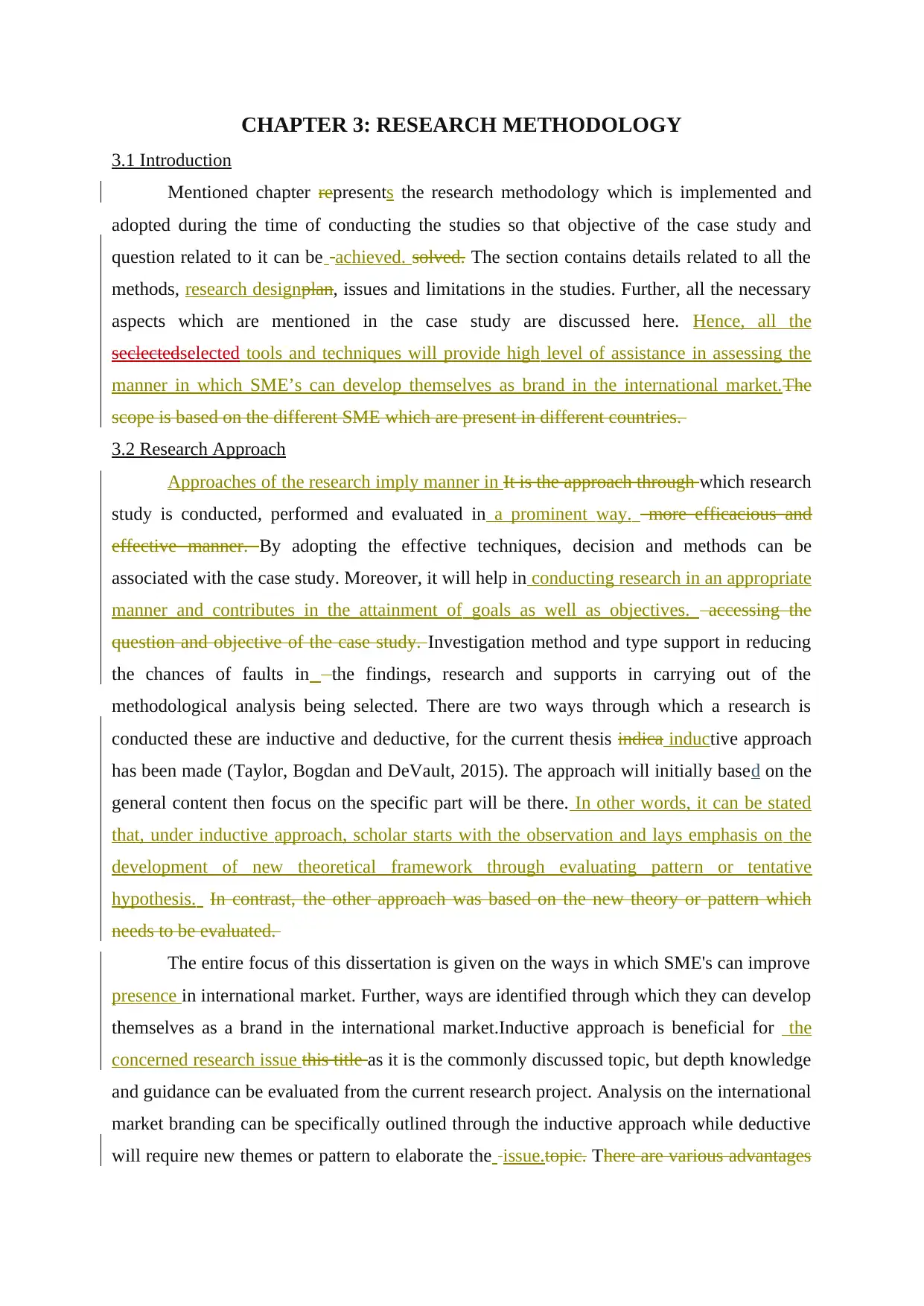
CHAPTER 3: RESEARCH METHODOLOGY
3.1 Introduction
Mentioned chapter represents the research methodology which is implemented and
adopted during the time of conducting the studies so that objective of the case study and
question related to it can be achieved. solved. The section contains details related to all the
methods, research designplan, issues and limitations in the studies. Further, all the necessary
aspects which are mentioned in the case study are discussed here. Hence, all the
seclectedselected tools and techniques will provide high level of assistance in assessing the
manner in which SME’s can develop themselves as brand in the international market.The
scope is based on the different SME which are present in different countries.
3.2 Research Approach
Approaches of the research imply manner in It is the approach through which research
study is conducted, performed and evaluated in a prominent way. more efficacious and
effective manner. By adopting the effective techniques, decision and methods can be
associated with the case study. Moreover, it will help in conducting research in an appropriate
manner and contributes in the attainment of goals as well as objectives. accessing the
question and objective of the case study. Investigation method and type support in reducing
the chances of faults in the findings, research and supports in carrying out of the
methodological analysis being selected. There are two ways through which a research is
conducted these are inductive and deductive, for the current thesis indica inductive approach
has been made (Taylor, Bogdan and DeVault, 2015). The approach will initially based on the
general content then focus on the specific part will be there. In other words, it can be stated
that, under inductive approach, scholar starts with the observation and lays emphasis on the
development of new theoretical framework through evaluating pattern or tentative
hypothesis. In contrast, the other approach was based on the new theory or pattern which
needs to be evaluated.
The entire focus of this dissertation is given on the ways in which SME's can improve
presence in international market. Further, ways are identified through which they can develop
themselves as a brand in the international market.Inductive approach is beneficial for the
concerned research issue this title as it is the commonly discussed topic, but depth knowledge
and guidance can be evaluated from the current research project. Analysis on the international
market branding can be specifically outlined through the inductive approach while deductive
will require new themes or pattern to elaborate the issue.topic. There are various advantages
3.1 Introduction
Mentioned chapter represents the research methodology which is implemented and
adopted during the time of conducting the studies so that objective of the case study and
question related to it can be achieved. solved. The section contains details related to all the
methods, research designplan, issues and limitations in the studies. Further, all the necessary
aspects which are mentioned in the case study are discussed here. Hence, all the
seclectedselected tools and techniques will provide high level of assistance in assessing the
manner in which SME’s can develop themselves as brand in the international market.The
scope is based on the different SME which are present in different countries.
3.2 Research Approach
Approaches of the research imply manner in It is the approach through which research
study is conducted, performed and evaluated in a prominent way. more efficacious and
effective manner. By adopting the effective techniques, decision and methods can be
associated with the case study. Moreover, it will help in conducting research in an appropriate
manner and contributes in the attainment of goals as well as objectives. accessing the
question and objective of the case study. Investigation method and type support in reducing
the chances of faults in the findings, research and supports in carrying out of the
methodological analysis being selected. There are two ways through which a research is
conducted these are inductive and deductive, for the current thesis indica inductive approach
has been made (Taylor, Bogdan and DeVault, 2015). The approach will initially based on the
general content then focus on the specific part will be there. In other words, it can be stated
that, under inductive approach, scholar starts with the observation and lays emphasis on the
development of new theoretical framework through evaluating pattern or tentative
hypothesis. In contrast, the other approach was based on the new theory or pattern which
needs to be evaluated.
The entire focus of this dissertation is given on the ways in which SME's can improve
presence in international market. Further, ways are identified through which they can develop
themselves as a brand in the international market.Inductive approach is beneficial for the
concerned research issue this title as it is the commonly discussed topic, but depth knowledge
and guidance can be evaluated from the current research project. Analysis on the international
market branding can be specifically outlined through the inductive approach while deductive
will require new themes or pattern to elaborate the issue.topic. There are various advantages
Paraphrase This Document
Need a fresh take? Get an instant paraphrase of this document with our AI Paraphraser
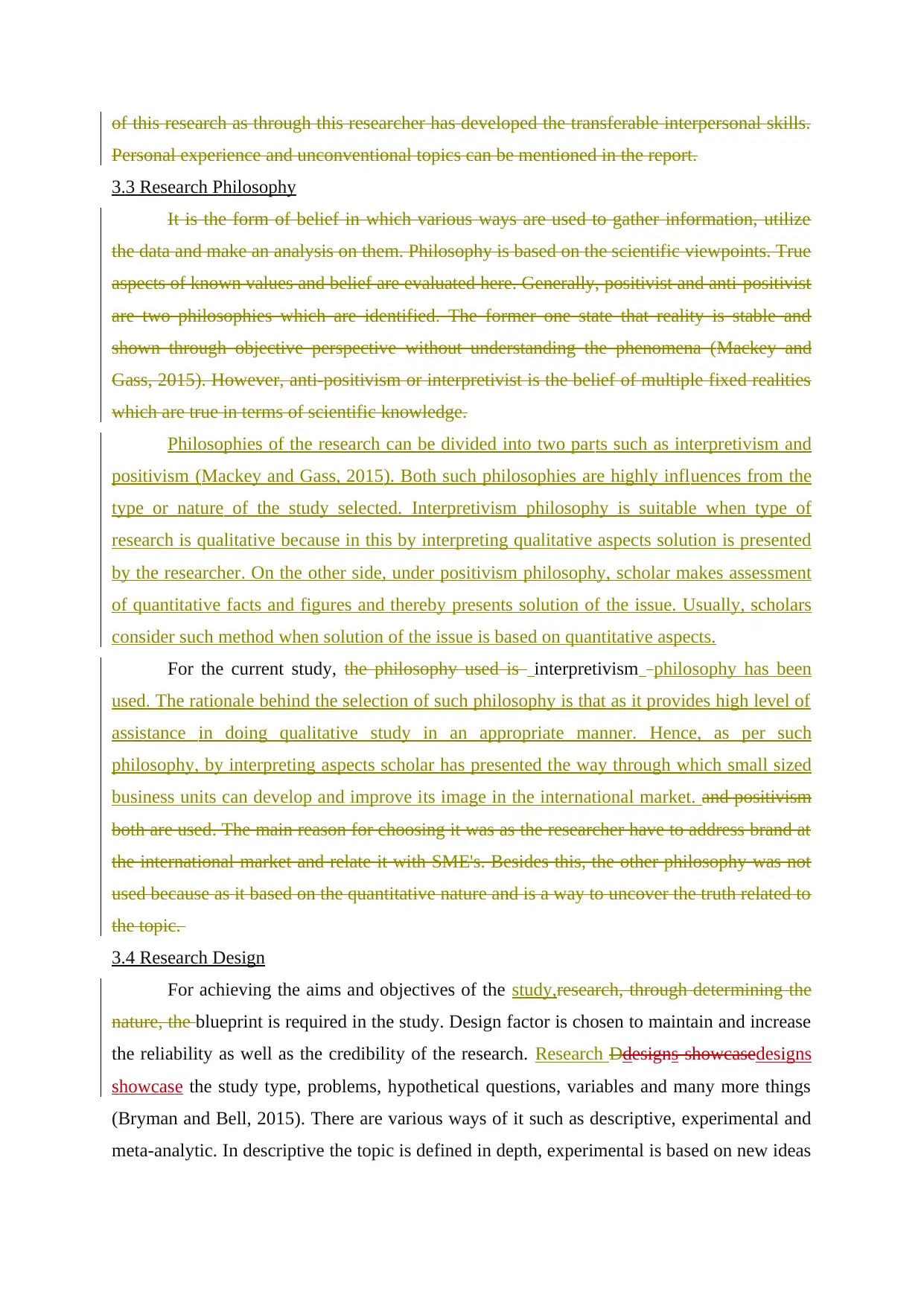
of this research as through this researcher has developed the transferable interpersonal skills.
Personal experience and unconventional topics can be mentioned in the report.
3.3 Research Philosophy
It is the form of belief in which various ways are used to gather information, utilize
the data and make an analysis on them. Philosophy is based on the scientific viewpoints. True
aspects of known values and belief are evaluated here. Generally, positivist and anti-positivist
are two philosophies which are identified. The former one state that reality is stable and
shown through objective perspective without understanding the phenomena (Mackey and
Gass, 2015). However, anti-positivism or interpretivist is the belief of multiple fixed realities
which are true in terms of scientific knowledge.
Philosophies of the research can be divided into two parts such as interpretivism and
positivism (Mackey and Gass, 2015). Both such philosophies are highly influences from the
type or nature of the study selected. Interpretivism philosophy is suitable when type of
research is qualitative because in this by interpreting qualitative aspects solution is presented
by the researcher. On the other side, under positivism philosophy, scholar makes assessment
of quantitative facts and figures and thereby presents solution of the issue. Usually, scholars
consider such method when solution of the issue is based on quantitative aspects.
For the current study, the philosophy used is interpretivism philosophy has been
used. The rationale behind the selection of such philosophy is that as it provides high level of
assistance in doing qualitative study in an appropriate manner. Hence, as per such
philosophy, by interpreting aspects scholar has presented the way through which small sized
business units can develop and improve its image in the international market. and positivism
both are used. The main reason for choosing it was as the researcher have to address brand at
the international market and relate it with SME's. Besides this, the other philosophy was not
used because as it based on the quantitative nature and is a way to uncover the truth related to
the topic.
3.4 Research Design
For achieving the aims and objectives of the study,research, through determining the
nature, the blueprint is required in the study. Design factor is chosen to maintain and increase
the reliability as well as the credibility of the research. Research Ddesigns showcasedesigns
showcase the study type, problems, hypothetical questions, variables and many more things
(Bryman and Bell, 2015). There are various ways of it such as descriptive, experimental and
meta-analytic. In descriptive the topic is defined in depth, experimental is based on new ideas
Personal experience and unconventional topics can be mentioned in the report.
3.3 Research Philosophy
It is the form of belief in which various ways are used to gather information, utilize
the data and make an analysis on them. Philosophy is based on the scientific viewpoints. True
aspects of known values and belief are evaluated here. Generally, positivist and anti-positivist
are two philosophies which are identified. The former one state that reality is stable and
shown through objective perspective without understanding the phenomena (Mackey and
Gass, 2015). However, anti-positivism or interpretivist is the belief of multiple fixed realities
which are true in terms of scientific knowledge.
Philosophies of the research can be divided into two parts such as interpretivism and
positivism (Mackey and Gass, 2015). Both such philosophies are highly influences from the
type or nature of the study selected. Interpretivism philosophy is suitable when type of
research is qualitative because in this by interpreting qualitative aspects solution is presented
by the researcher. On the other side, under positivism philosophy, scholar makes assessment
of quantitative facts and figures and thereby presents solution of the issue. Usually, scholars
consider such method when solution of the issue is based on quantitative aspects.
For the current study, the philosophy used is interpretivism philosophy has been
used. The rationale behind the selection of such philosophy is that as it provides high level of
assistance in doing qualitative study in an appropriate manner. Hence, as per such
philosophy, by interpreting aspects scholar has presented the way through which small sized
business units can develop and improve its image in the international market. and positivism
both are used. The main reason for choosing it was as the researcher have to address brand at
the international market and relate it with SME's. Besides this, the other philosophy was not
used because as it based on the quantitative nature and is a way to uncover the truth related to
the topic.
3.4 Research Design
For achieving the aims and objectives of the study,research, through determining the
nature, the blueprint is required in the study. Design factor is chosen to maintain and increase
the reliability as well as the credibility of the research. Research Ddesigns showcasedesigns
showcase the study type, problems, hypothetical questions, variables and many more things
(Bryman and Bell, 2015). There are various ways of it such as descriptive, experimental and
meta-analytic. In descriptive the topic is defined in depth, experimental is based on new ideas
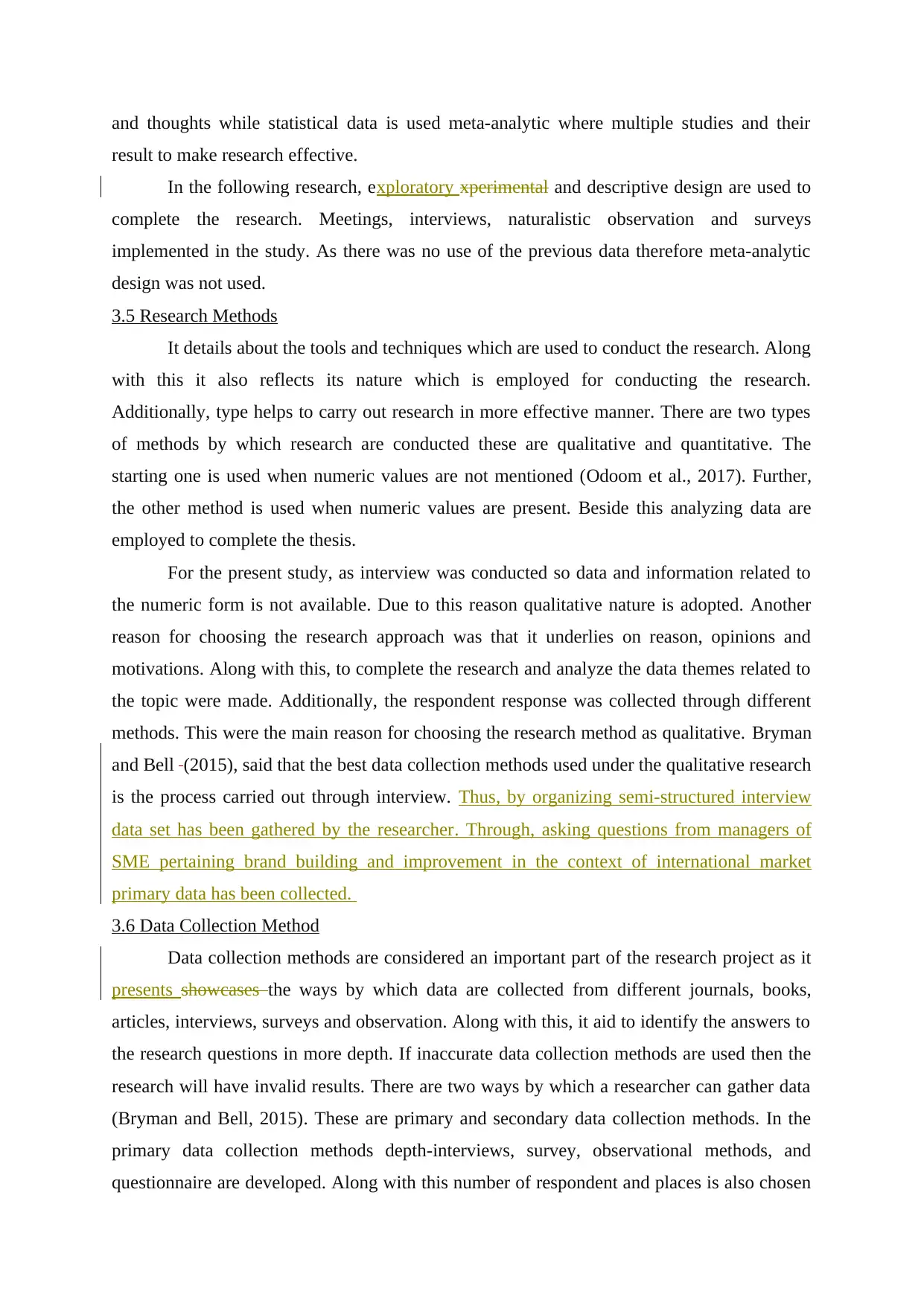
and thoughts while statistical data is used meta-analytic where multiple studies and their
result to make research effective.
In the following research, exploratory xperimental and descriptive design are used to
complete the research. Meetings, interviews, naturalistic observation and surveys
implemented in the study. As there was no use of the previous data therefore meta-analytic
design was not used.
3.5 Research Methods
It details about the tools and techniques which are used to conduct the research. Along
with this it also reflects its nature which is employed for conducting the research.
Additionally, type helps to carry out research in more effective manner. There are two types
of methods by which research are conducted these are qualitative and quantitative. The
starting one is used when numeric values are not mentioned (Odoom et al., 2017). Further,
the other method is used when numeric values are present. Beside this analyzing data are
employed to complete the thesis.
For the present study, as interview was conducted so data and information related to
the numeric form is not available. Due to this reason qualitative nature is adopted. Another
reason for choosing the research approach was that it underlies on reason, opinions and
motivations. Along with this, to complete the research and analyze the data themes related to
the topic were made. Additionally, the respondent response was collected through different
methods. This were the main reason for choosing the research method as qualitative. Bryman
and Bell (2015), said that the best data collection methods used under the qualitative research
is the process carried out through interview. Thus, by organizing semi-structured interview
data set has been gathered by the researcher. Through, asking questions from managers of
SME pertaining brand building and improvement in the context of international market
primary data has been collected.
3.6 Data Collection Method
Data collection methods are considered an important part of the research project as it
presents showcases the ways by which data are collected from different journals, books,
articles, interviews, surveys and observation. Along with this, it aid to identify the answers to
the research questions in more depth. If inaccurate data collection methods are used then the
research will have invalid results. There are two ways by which a researcher can gather data
(Bryman and Bell, 2015). These are primary and secondary data collection methods. In the
primary data collection methods depth-interviews, survey, observational methods, and
questionnaire are developed. Along with this number of respondent and places is also chosen
result to make research effective.
In the following research, exploratory xperimental and descriptive design are used to
complete the research. Meetings, interviews, naturalistic observation and surveys
implemented in the study. As there was no use of the previous data therefore meta-analytic
design was not used.
3.5 Research Methods
It details about the tools and techniques which are used to conduct the research. Along
with this it also reflects its nature which is employed for conducting the research.
Additionally, type helps to carry out research in more effective manner. There are two types
of methods by which research are conducted these are qualitative and quantitative. The
starting one is used when numeric values are not mentioned (Odoom et al., 2017). Further,
the other method is used when numeric values are present. Beside this analyzing data are
employed to complete the thesis.
For the present study, as interview was conducted so data and information related to
the numeric form is not available. Due to this reason qualitative nature is adopted. Another
reason for choosing the research approach was that it underlies on reason, opinions and
motivations. Along with this, to complete the research and analyze the data themes related to
the topic were made. Additionally, the respondent response was collected through different
methods. This were the main reason for choosing the research method as qualitative. Bryman
and Bell (2015), said that the best data collection methods used under the qualitative research
is the process carried out through interview. Thus, by organizing semi-structured interview
data set has been gathered by the researcher. Through, asking questions from managers of
SME pertaining brand building and improvement in the context of international market
primary data has been collected.
3.6 Data Collection Method
Data collection methods are considered an important part of the research project as it
presents showcases the ways by which data are collected from different journals, books,
articles, interviews, surveys and observation. Along with this, it aid to identify the answers to
the research questions in more depth. If inaccurate data collection methods are used then the
research will have invalid results. There are two ways by which a researcher can gather data
(Bryman and Bell, 2015). These are primary and secondary data collection methods. In the
primary data collection methods depth-interviews, survey, observational methods, and
questionnaire are developed. Along with this number of respondent and places is also chosen
⊘ This is a preview!⊘
Do you want full access?
Subscribe today to unlock all pages.

Trusted by 1+ million students worldwide
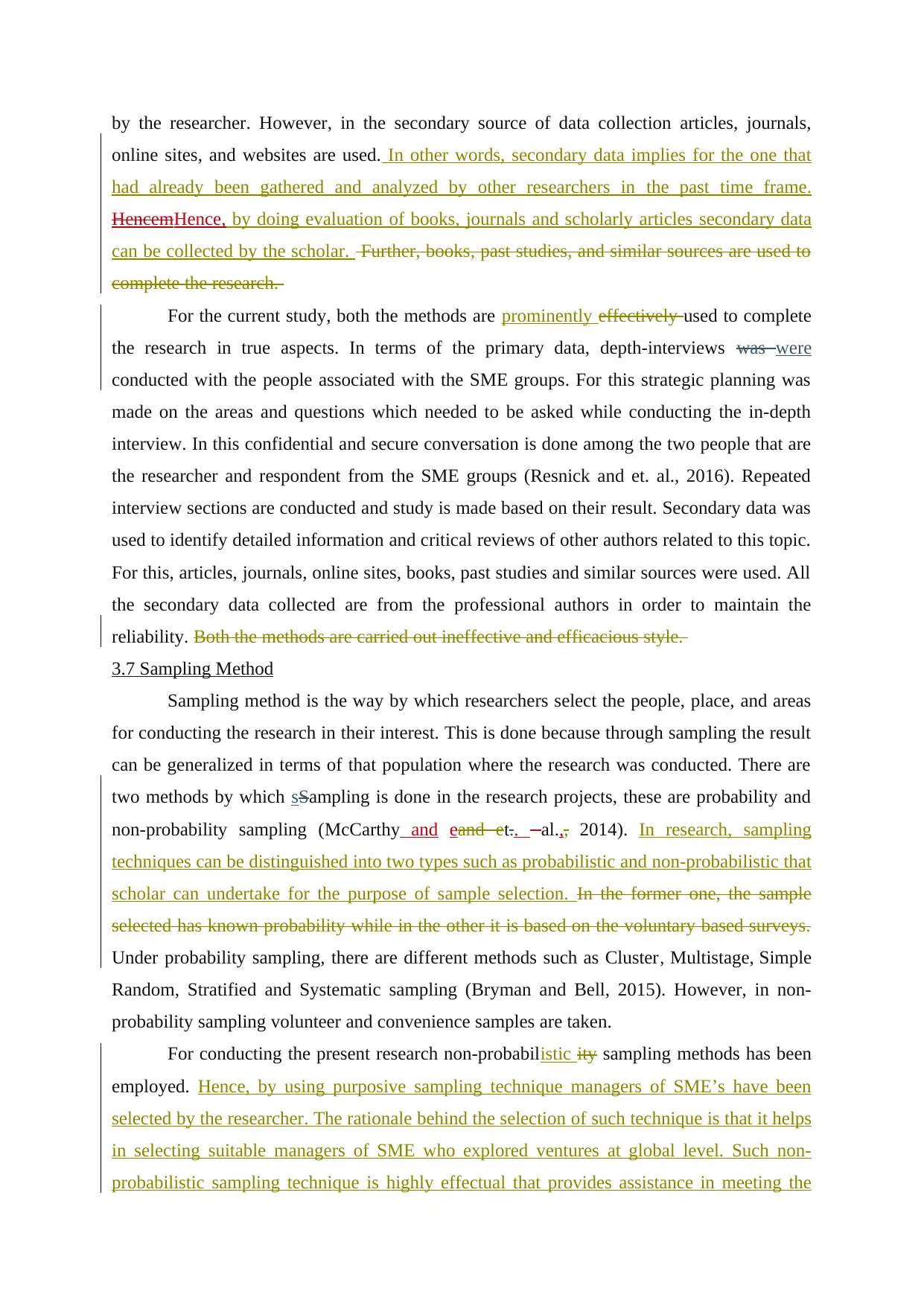
by the researcher. However, in the secondary source of data collection articles, journals,
online sites, and websites are used. In other words, secondary data implies for the one that
had already been gathered and analyzed by other researchers in the past time frame.
HencemHence, by doing evaluation of books, journals and scholarly articles secondary data
can be collected by the scholar. Further, books, past studies, and similar sources are used to
complete the research.
For the current study, both the methods are prominently effectively used to complete
the research in true aspects. In terms of the primary data, depth-interviews was were
conducted with the people associated with the SME groups. For this strategic planning was
made on the areas and questions which needed to be asked while conducting the in-depth
interview. In this confidential and secure conversation is done among the two people that are
the researcher and respondent from the SME groups (Resnick and et. al., 2016). Repeated
interview sections are conducted and study is made based on their result. Secondary data was
used to identify detailed information and critical reviews of other authors related to this topic.
For this, articles, journals, online sites, books, past studies and similar sources were used. All
the secondary data collected are from the professional authors in order to maintain the
reliability. Both the methods are carried out ineffective and efficacious style.
3.7 Sampling Method
Sampling method is the way by which researchers select the people, place, and areas
for conducting the research in their interest. This is done because through sampling the result
can be generalized in terms of that population where the research was conducted. There are
two methods by which sSampling is done in the research projects, these are probability and
non-probability sampling (McCarthy and eand et.. al.,, 2014). In research, sampling
techniques can be distinguished into two types such as probabilistic and non-probabilistic that
scholar can undertake for the purpose of sample selection. In the former one, the sample
selected has known probability while in the other it is based on the voluntary based surveys.
Under probability sampling, there are different methods such as Cluster, Multistage, Simple
Random, Stratified and Systematic sampling (Bryman and Bell, 2015). However, in non-
probability sampling volunteer and convenience samples are taken.
For conducting the present research non-probabilistic ity sampling methods has been
employed. Hence, by using purposive sampling technique managers of SME’s have been
selected by the researcher. The rationale behind the selection of such technique is that it helps
in selecting suitable managers of SME who explored ventures at global level. Such non-
probabilistic sampling technique is highly effectual that provides assistance in meeting the
online sites, and websites are used. In other words, secondary data implies for the one that
had already been gathered and analyzed by other researchers in the past time frame.
HencemHence, by doing evaluation of books, journals and scholarly articles secondary data
can be collected by the scholar. Further, books, past studies, and similar sources are used to
complete the research.
For the current study, both the methods are prominently effectively used to complete
the research in true aspects. In terms of the primary data, depth-interviews was were
conducted with the people associated with the SME groups. For this strategic planning was
made on the areas and questions which needed to be asked while conducting the in-depth
interview. In this confidential and secure conversation is done among the two people that are
the researcher and respondent from the SME groups (Resnick and et. al., 2016). Repeated
interview sections are conducted and study is made based on their result. Secondary data was
used to identify detailed information and critical reviews of other authors related to this topic.
For this, articles, journals, online sites, books, past studies and similar sources were used. All
the secondary data collected are from the professional authors in order to maintain the
reliability. Both the methods are carried out ineffective and efficacious style.
3.7 Sampling Method
Sampling method is the way by which researchers select the people, place, and areas
for conducting the research in their interest. This is done because through sampling the result
can be generalized in terms of that population where the research was conducted. There are
two methods by which sSampling is done in the research projects, these are probability and
non-probability sampling (McCarthy and eand et.. al.,, 2014). In research, sampling
techniques can be distinguished into two types such as probabilistic and non-probabilistic that
scholar can undertake for the purpose of sample selection. In the former one, the sample
selected has known probability while in the other it is based on the voluntary based surveys.
Under probability sampling, there are different methods such as Cluster, Multistage, Simple
Random, Stratified and Systematic sampling (Bryman and Bell, 2015). However, in non-
probability sampling volunteer and convenience samples are taken.
For conducting the present research non-probabilistic ity sampling methods has been
employed. Hence, by using purposive sampling technique managers of SME’s have been
selected by the researcher. The rationale behind the selection of such technique is that it helps
in selecting suitable managers of SME who explored ventures at global level. Such non-
probabilistic sampling technique is highly effectual that provides assistance in meeting the
Paraphrase This Document
Need a fresh take? Get an instant paraphrase of this document with our AI Paraphraser
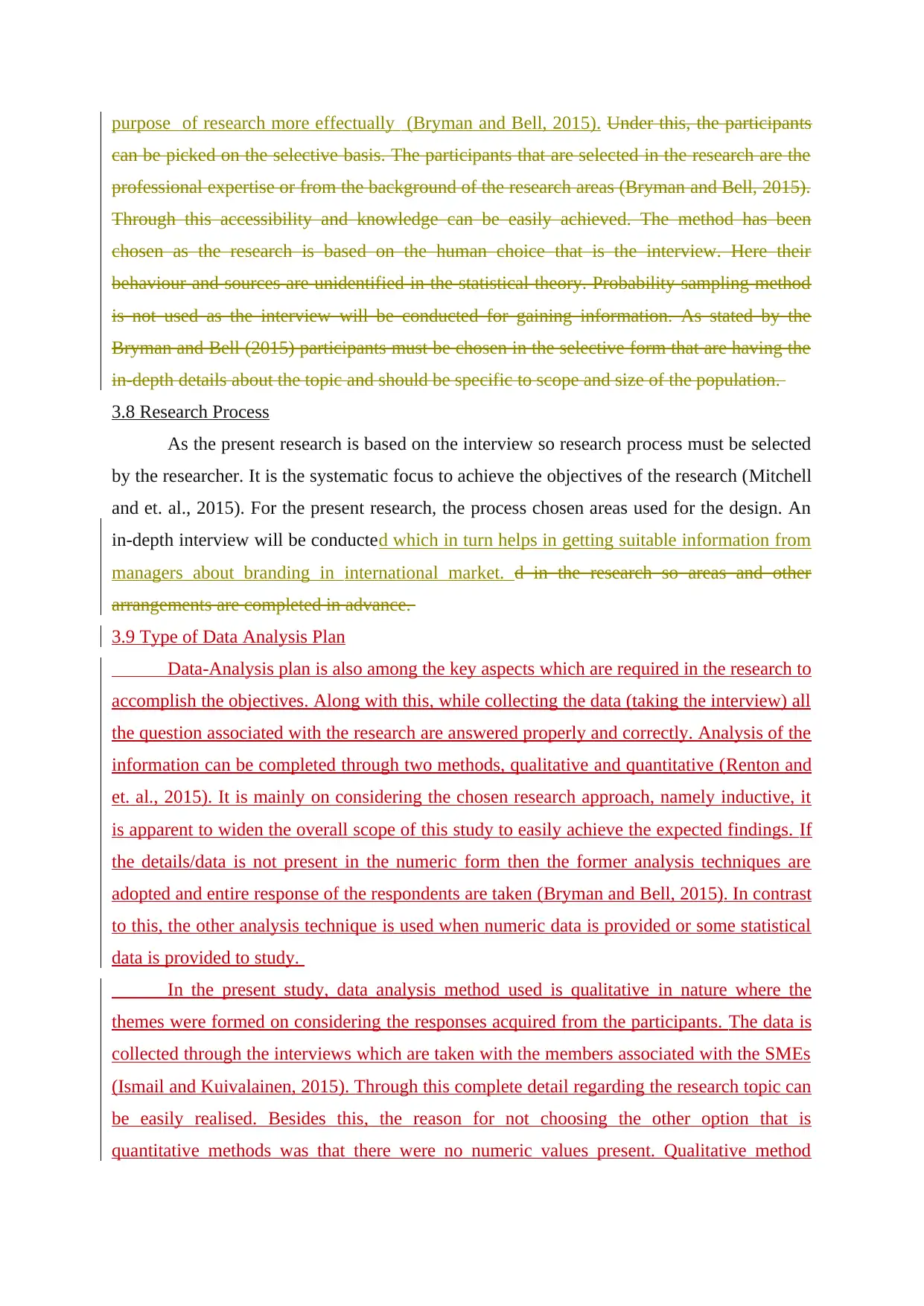
purpose of research more effectually (Bryman and Bell, 2015). Under this, the participants
can be picked on the selective basis. The participants that are selected in the research are the
professional expertise or from the background of the research areas (Bryman and Bell, 2015).
Through this accessibility and knowledge can be easily achieved. The method has been
chosen as the research is based on the human choice that is the interview. Here their
behaviour and sources are unidentified in the statistical theory. Probability sampling method
is not used as the interview will be conducted for gaining information. As stated by the
Bryman and Bell (2015) participants must be chosen in the selective form that are having the
in-depth details about the topic and should be specific to scope and size of the population.
3.8 Research Process
As the present research is based on the interview so research process must be selected
by the researcher. It is the systematic focus to achieve the objectives of the research (Mitchell
and et. al., 2015). For the present research, the process chosen areas used for the design. An
in-depth interview will be conducted which in turn helps in getting suitable information from
managers about branding in international market. d in the research so areas and other
arrangements are completed in advance.
3.9 Type of Data Analysis Plan
Data-Analysis plan is also among the key aspects which are required in the research to
accomplish the objectives. Along with this, while collecting the data (taking the interview) all
the question associated with the research are answered properly and correctly. Analysis of the
information can be completed through two methods, qualitative and quantitative (Renton and
et. al., 2015). It is mainly on considering the chosen research approach, namely inductive, it
is apparent to widen the overall scope of this study to easily achieve the expected findings. If
the details/data is not present in the numeric form then the former analysis techniques are
adopted and entire response of the respondents are taken (Bryman and Bell, 2015). In contrast
to this, the other analysis technique is used when numeric data is provided or some statistical
data is provided to study.
In the present study, data analysis method used is qualitative in nature where the
themes were formed on considering the responses acquired from the participants. The data is
collected through the interviews which are taken with the members associated with the SMEs
(Ismail and Kuivalainen, 2015). Through this complete detail regarding the research topic can
be easily realised. Besides this, the reason for not choosing the other option that is
quantitative methods was that there were no numeric values present. Qualitative method
can be picked on the selective basis. The participants that are selected in the research are the
professional expertise or from the background of the research areas (Bryman and Bell, 2015).
Through this accessibility and knowledge can be easily achieved. The method has been
chosen as the research is based on the human choice that is the interview. Here their
behaviour and sources are unidentified in the statistical theory. Probability sampling method
is not used as the interview will be conducted for gaining information. As stated by the
Bryman and Bell (2015) participants must be chosen in the selective form that are having the
in-depth details about the topic and should be specific to scope and size of the population.
3.8 Research Process
As the present research is based on the interview so research process must be selected
by the researcher. It is the systematic focus to achieve the objectives of the research (Mitchell
and et. al., 2015). For the present research, the process chosen areas used for the design. An
in-depth interview will be conducted which in turn helps in getting suitable information from
managers about branding in international market. d in the research so areas and other
arrangements are completed in advance.
3.9 Type of Data Analysis Plan
Data-Analysis plan is also among the key aspects which are required in the research to
accomplish the objectives. Along with this, while collecting the data (taking the interview) all
the question associated with the research are answered properly and correctly. Analysis of the
information can be completed through two methods, qualitative and quantitative (Renton and
et. al., 2015). It is mainly on considering the chosen research approach, namely inductive, it
is apparent to widen the overall scope of this study to easily achieve the expected findings. If
the details/data is not present in the numeric form then the former analysis techniques are
adopted and entire response of the respondents are taken (Bryman and Bell, 2015). In contrast
to this, the other analysis technique is used when numeric data is provided or some statistical
data is provided to study.
In the present study, data analysis method used is qualitative in nature where the
themes were formed on considering the responses acquired from the participants. The data is
collected through the interviews which are taken with the members associated with the SMEs
(Ismail and Kuivalainen, 2015). Through this complete detail regarding the research topic can
be easily realised. Besides this, the reason for not choosing the other option that is
quantitative methods was that there were no numeric values present. Qualitative method
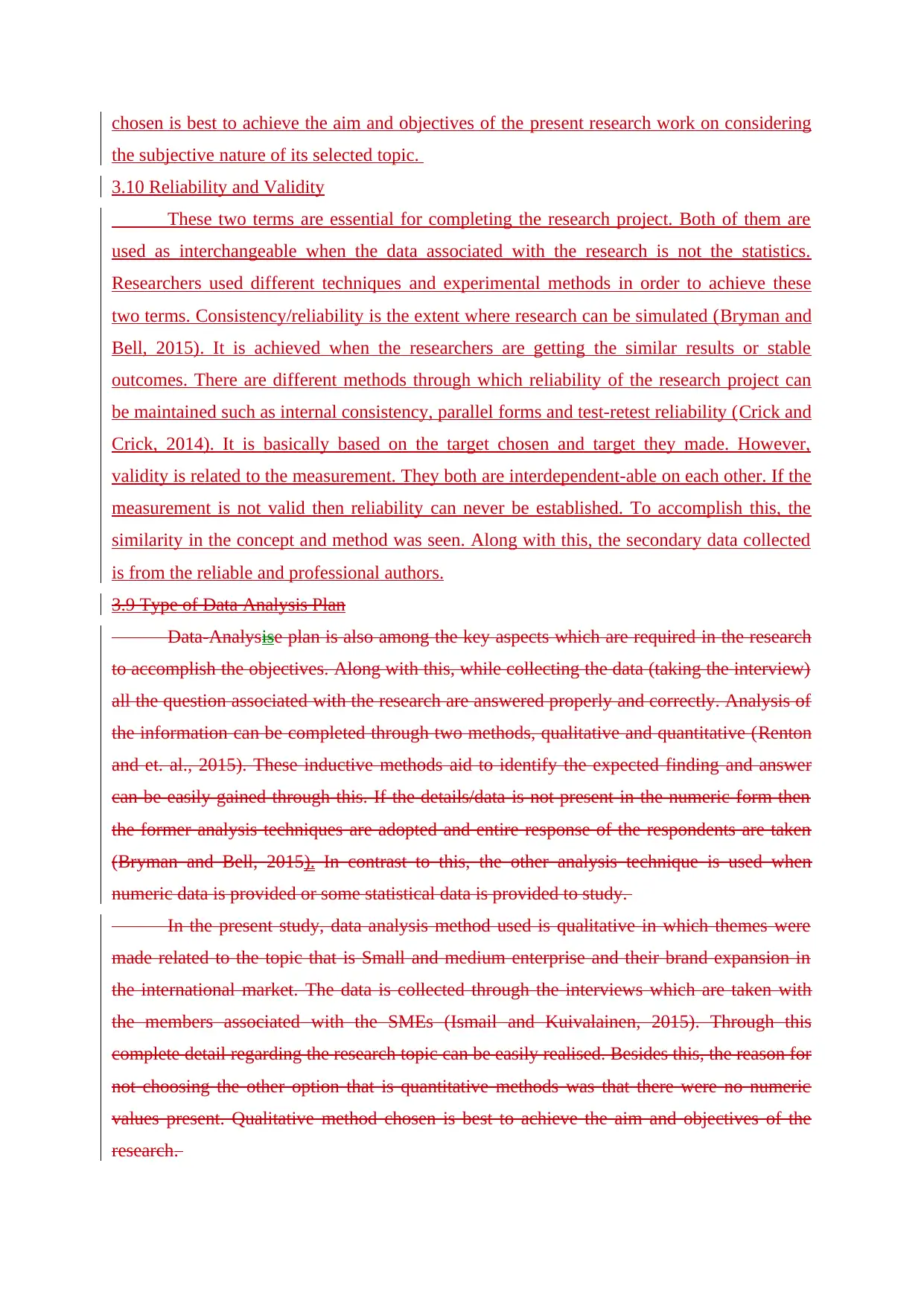
chosen is best to achieve the aim and objectives of the present research work on considering
the subjective nature of its selected topic.
3.10 Reliability and Validity
These two terms are essential for completing the research project. Both of them are
used as interchangeable when the data associated with the research is not the statistics.
Researchers used different techniques and experimental methods in order to achieve these
two terms. Consistency/reliability is the extent where research can be simulated (Bryman and
Bell, 2015). It is achieved when the researchers are getting the similar results or stable
outcomes. There are different methods through which reliability of the research project can
be maintained such as internal consistency, parallel forms and test-retest reliability (Crick and
Crick, 2014). It is basically based on the target chosen and target they made. However,
validity is related to the measurement. They both are interdependent-able on each other. If the
measurement is not valid then reliability can never be established. To accomplish this, the
similarity in the concept and method was seen. Along with this, the secondary data collected
is from the reliable and professional authors.
3.9 Type of Data Analysis Plan
Data-Analysise plan is also among the key aspects which are required in the research
to accomplish the objectives. Along with this, while collecting the data (taking the interview)
all the question associated with the research are answered properly and correctly. Analysis of
the information can be completed through two methods, qualitative and quantitative (Renton
and et. al., 2015). These inductive methods aid to identify the expected finding and answer
can be easily gained through this. If the details/data is not present in the numeric form then
the former analysis techniques are adopted and entire response of the respondents are taken
(Bryman and Bell, 2015). In contrast to this, the other analysis technique is used when
numeric data is provided or some statistical data is provided to study.
In the present study, data analysis method used is qualitative in which themes were
made related to the topic that is Small and medium enterprise and their brand expansion in
the international market. The data is collected through the interviews which are taken with
the members associated with the SMEs (Ismail and Kuivalainen, 2015). Through this
complete detail regarding the research topic can be easily realised. Besides this, the reason for
not choosing the other option that is quantitative methods was that there were no numeric
values present. Qualitative method chosen is best to achieve the aim and objectives of the
research.
the subjective nature of its selected topic.
3.10 Reliability and Validity
These two terms are essential for completing the research project. Both of them are
used as interchangeable when the data associated with the research is not the statistics.
Researchers used different techniques and experimental methods in order to achieve these
two terms. Consistency/reliability is the extent where research can be simulated (Bryman and
Bell, 2015). It is achieved when the researchers are getting the similar results or stable
outcomes. There are different methods through which reliability of the research project can
be maintained such as internal consistency, parallel forms and test-retest reliability (Crick and
Crick, 2014). It is basically based on the target chosen and target they made. However,
validity is related to the measurement. They both are interdependent-able on each other. If the
measurement is not valid then reliability can never be established. To accomplish this, the
similarity in the concept and method was seen. Along with this, the secondary data collected
is from the reliable and professional authors.
3.9 Type of Data Analysis Plan
Data-Analysise plan is also among the key aspects which are required in the research
to accomplish the objectives. Along with this, while collecting the data (taking the interview)
all the question associated with the research are answered properly and correctly. Analysis of
the information can be completed through two methods, qualitative and quantitative (Renton
and et. al., 2015). These inductive methods aid to identify the expected finding and answer
can be easily gained through this. If the details/data is not present in the numeric form then
the former analysis techniques are adopted and entire response of the respondents are taken
(Bryman and Bell, 2015). In contrast to this, the other analysis technique is used when
numeric data is provided or some statistical data is provided to study.
In the present study, data analysis method used is qualitative in which themes were
made related to the topic that is Small and medium enterprise and their brand expansion in
the international market. The data is collected through the interviews which are taken with
the members associated with the SMEs (Ismail and Kuivalainen, 2015). Through this
complete detail regarding the research topic can be easily realised. Besides this, the reason for
not choosing the other option that is quantitative methods was that there were no numeric
values present. Qualitative method chosen is best to achieve the aim and objectives of the
research.
⊘ This is a preview!⊘
Do you want full access?
Subscribe today to unlock all pages.

Trusted by 1+ million students worldwide
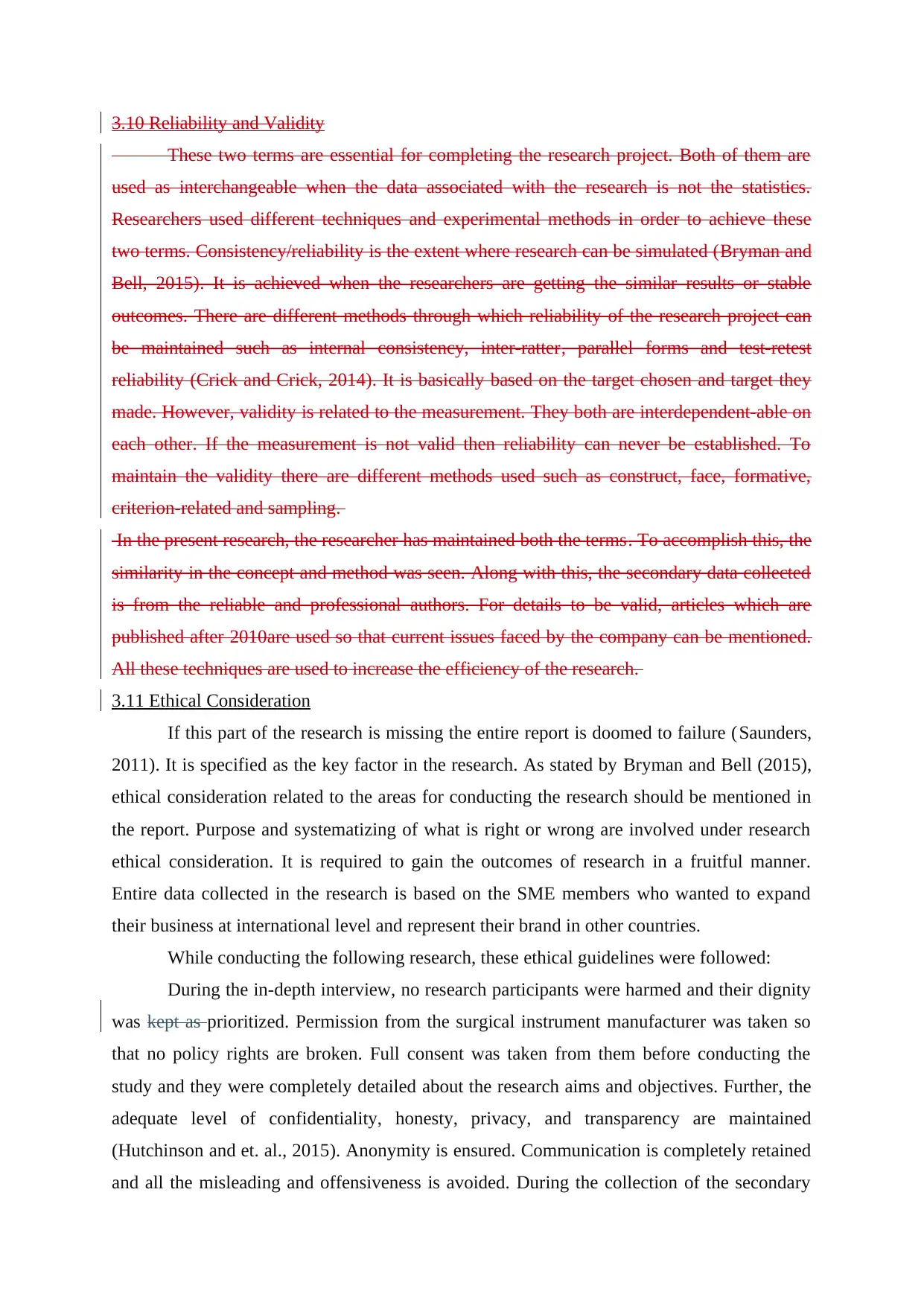
3.10 Reliability and Validity
These two terms are essential for completing the research project. Both of them are
used as interchangeable when the data associated with the research is not the statistics.
Researchers used different techniques and experimental methods in order to achieve these
two terms. Consistency/reliability is the extent where research can be simulated (Bryman and
Bell, 2015). It is achieved when the researchers are getting the similar results or stable
outcomes. There are different methods through which reliability of the research project can
be maintained such as internal consistency, inter-ratter, parallel forms and test-retest
reliability (Crick and Crick, 2014). It is basically based on the target chosen and target they
made. However, validity is related to the measurement. They both are interdependent-able on
each other. If the measurement is not valid then reliability can never be established. To
maintain the validity there are different methods used such as construct, face, formative,
criterion-related and sampling.
In the present research, the researcher has maintained both the terms. To accomplish this, the
similarity in the concept and method was seen. Along with this, the secondary data collected
is from the reliable and professional authors. For details to be valid, articles which are
published after 2010are used so that current issues faced by the company can be mentioned.
All these techniques are used to increase the efficiency of the research.
3.11 Ethical Consideration
If this part of the research is missing the entire report is doomed to failure (Saunders,
2011). It is specified as the key factor in the research. As stated by Bryman and Bell (2015),
ethical consideration related to the areas for conducting the research should be mentioned in
the report. Purpose and systematizing of what is right or wrong are involved under research
ethical consideration. It is required to gain the outcomes of research in a fruitful manner.
Entire data collected in the research is based on the SME members who wanted to expand
their business at international level and represent their brand in other countries.
While conducting the following research, these ethical guidelines were followed:
During the in-depth interview, no research participants were harmed and their dignity
was kept as prioritized. Permission from the surgical instrument manufacturer was taken so
that no policy rights are broken. Full consent was taken from them before conducting the
study and they were completely detailed about the research aims and objectives. Further, the
adequate level of confidentiality, honesty, privacy, and transparency are maintained
(Hutchinson and et. al., 2015). Anonymity is ensured. Communication is completely retained
and all the misleading and offensiveness is avoided. During the collection of the secondary
These two terms are essential for completing the research project. Both of them are
used as interchangeable when the data associated with the research is not the statistics.
Researchers used different techniques and experimental methods in order to achieve these
two terms. Consistency/reliability is the extent where research can be simulated (Bryman and
Bell, 2015). It is achieved when the researchers are getting the similar results or stable
outcomes. There are different methods through which reliability of the research project can
be maintained such as internal consistency, inter-ratter, parallel forms and test-retest
reliability (Crick and Crick, 2014). It is basically based on the target chosen and target they
made. However, validity is related to the measurement. They both are interdependent-able on
each other. If the measurement is not valid then reliability can never be established. To
maintain the validity there are different methods used such as construct, face, formative,
criterion-related and sampling.
In the present research, the researcher has maintained both the terms. To accomplish this, the
similarity in the concept and method was seen. Along with this, the secondary data collected
is from the reliable and professional authors. For details to be valid, articles which are
published after 2010are used so that current issues faced by the company can be mentioned.
All these techniques are used to increase the efficiency of the research.
3.11 Ethical Consideration
If this part of the research is missing the entire report is doomed to failure (Saunders,
2011). It is specified as the key factor in the research. As stated by Bryman and Bell (2015),
ethical consideration related to the areas for conducting the research should be mentioned in
the report. Purpose and systematizing of what is right or wrong are involved under research
ethical consideration. It is required to gain the outcomes of research in a fruitful manner.
Entire data collected in the research is based on the SME members who wanted to expand
their business at international level and represent their brand in other countries.
While conducting the following research, these ethical guidelines were followed:
During the in-depth interview, no research participants were harmed and their dignity
was kept as prioritized. Permission from the surgical instrument manufacturer was taken so
that no policy rights are broken. Full consent was taken from them before conducting the
study and they were completely detailed about the research aims and objectives. Further, the
adequate level of confidentiality, honesty, privacy, and transparency are maintained
(Hutchinson and et. al., 2015). Anonymity is ensured. Communication is completely retained
and all the misleading and offensiveness is avoided. During the collection of the secondary
Paraphrase This Document
Need a fresh take? Get an instant paraphrase of this document with our AI Paraphraser
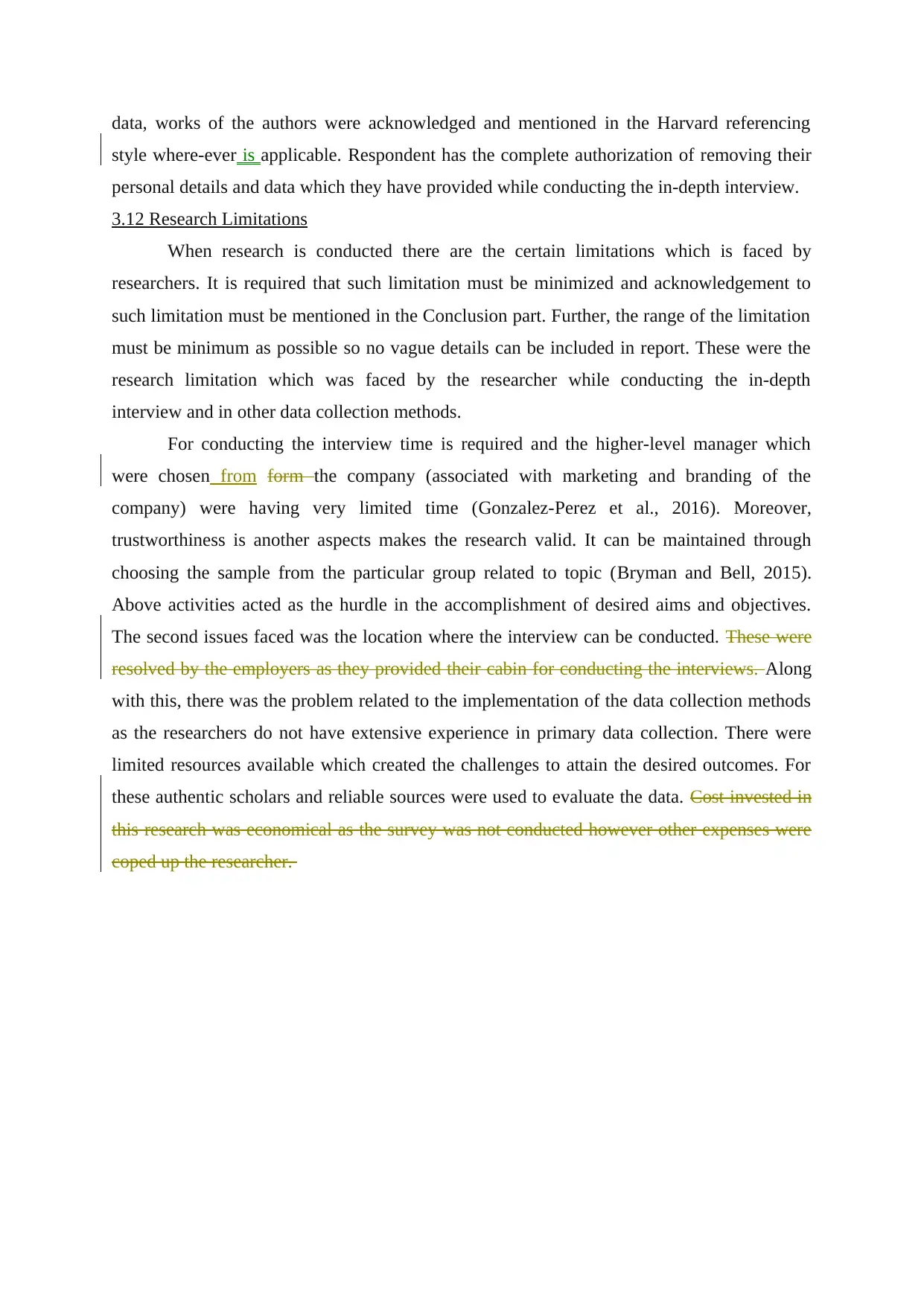
data, works of the authors were acknowledged and mentioned in the Harvard referencing
style where-ever is applicable. Respondent has the complete authorization of removing their
personal details and data which they have provided while conducting the in-depth interview.
3.12 Research Limitations
When research is conducted there are the certain limitations which is faced by
researchers. It is required that such limitation must be minimized and acknowledgement to
such limitation must be mentioned in the Conclusion part. Further, the range of the limitation
must be minimum as possible so no vague details can be included in report. These were the
research limitation which was faced by the researcher while conducting the in-depth
interview and in other data collection methods.
For conducting the interview time is required and the higher-level manager which
were chosen from form the company (associated with marketing and branding of the
company) were having very limited time (Gonzalez-Perez et al., 2016). Moreover,
trustworthiness is another aspects makes the research valid. It can be maintained through
choosing the sample from the particular group related to topic (Bryman and Bell, 2015).
Above activities acted as the hurdle in the accomplishment of desired aims and objectives.
The second issues faced was the location where the interview can be conducted. These were
resolved by the employers as they provided their cabin for conducting the interviews. Along
with this, there was the problem related to the implementation of the data collection methods
as the researchers do not have extensive experience in primary data collection. There were
limited resources available which created the challenges to attain the desired outcomes. For
these authentic scholars and reliable sources were used to evaluate the data. Cost invested in
this research was economical as the survey was not conducted however other expenses were
coped up the researcher.
style where-ever is applicable. Respondent has the complete authorization of removing their
personal details and data which they have provided while conducting the in-depth interview.
3.12 Research Limitations
When research is conducted there are the certain limitations which is faced by
researchers. It is required that such limitation must be minimized and acknowledgement to
such limitation must be mentioned in the Conclusion part. Further, the range of the limitation
must be minimum as possible so no vague details can be included in report. These were the
research limitation which was faced by the researcher while conducting the in-depth
interview and in other data collection methods.
For conducting the interview time is required and the higher-level manager which
were chosen from form the company (associated with marketing and branding of the
company) were having very limited time (Gonzalez-Perez et al., 2016). Moreover,
trustworthiness is another aspects makes the research valid. It can be maintained through
choosing the sample from the particular group related to topic (Bryman and Bell, 2015).
Above activities acted as the hurdle in the accomplishment of desired aims and objectives.
The second issues faced was the location where the interview can be conducted. These were
resolved by the employers as they provided their cabin for conducting the interviews. Along
with this, there was the problem related to the implementation of the data collection methods
as the researchers do not have extensive experience in primary data collection. There were
limited resources available which created the challenges to attain the desired outcomes. For
these authentic scholars and reliable sources were used to evaluate the data. Cost invested in
this research was economical as the survey was not conducted however other expenses were
coped up the researcher.
1 out of 8
Related Documents
Your All-in-One AI-Powered Toolkit for Academic Success.
+13062052269
info@desklib.com
Available 24*7 on WhatsApp / Email
![[object Object]](/_next/static/media/star-bottom.7253800d.svg)
Unlock your academic potential
Copyright © 2020–2025 A2Z Services. All Rights Reserved. Developed and managed by ZUCOL.





